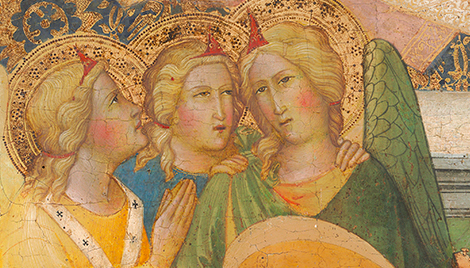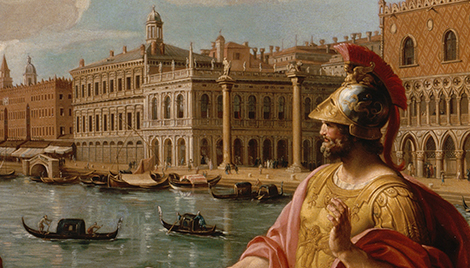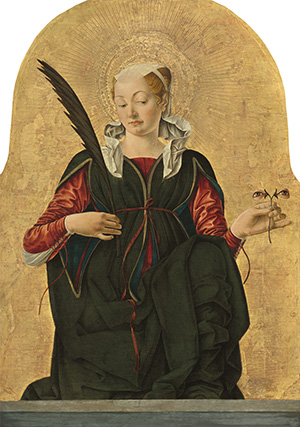Saint Lucy
Saint Lucy
- Artist
- Francesco del Cossa
- Artist Dates
- c. 1436-1477/1478
- Artist Nationality
- Italian
- Title
- Saint Lucy
- Date
- c. 1473/1474
- Medium
- tempera on poplar panel
- Dimensions
- 77.2 x 56 cm (30 3/8 x 22 1/16 in)
- K Number
- K417
- Repository
- National Gallery of Art
- Accession Number
- 1939.1.228
- Notes
Provenance
Commissioned by Floriano Griffoni for a family chapel (the sixth off the north aisle) in the church of San Petronio, Bologna; [1] moved to the Casa Aldrovandi, Bologna, c. 1731, but no longer there in 1782. [2] Count Ugo Beni, Gubbio, by 1858; [3] purchased 1881 or at (Beni sale, Gubbio, April 1882, no. 4, as _Saint Martin_ by Zoppo) by Joseph Spiridon [1845-1930], Paris; [4] (his sale, Cassirer and Helbing, Berlin, 31 May 1929, no. 12, as _Heilige Liberalis_); (Duveen Brothers, Inc., London and New York); [5] sold May 1936 to the Samuel H. Kress Foundation, New York; [6] gift 1939 to NGA. [1] The first mention of the altarpiece is in Giorgio Vasari's _Vite_. "Lorenzo Cossa" (a conflation of Cossa and Lorenzo Costa), in the 1550 life of Cossa's student Ercole de' Roberti ("Ercole Ferrarese", Vasari, ed. R. Bettarini and P. Barocchi, 3, part 1, 1971: 420), notes "E cosi in San Petronio, in una cappella, una tavola a tempera che si conosce a la maniera, con una predella sotto di figure piccole fatte con gran diligenzia" (And likewise [he painted] in San Petronio, in a chapel, an altarpiece in tempera recognizale by its style, with a predella beneath of small figures done with great diligence). In the 1568 edition of the _Lives_ (ed. Rosanna Bettarini and Paola Barocchi, 8+ vols., Florence, 1966-: 3, part 1(1971):419-420), Vasari provides further information, noting that the chapel was dedicated to Saint Vincent and that the predella, which Vasari considered of higher quality than the rest of the altarpiece, was painted by Ercole. The 1568 edition includes a separate biography for "Lorenzo Costa" (the same Cossa-Costa conflation with a slightly different name) mentioning the chapel's donors, the Griffoni (Vasari, ed. Bettarini and Barocchi, 3, part 1, 1971: 415-416). That the Griffoni patron of the altarpiece was Floriano is demonstrated by a document of 19 July 1473 (_Archivio di San Petronio, Vacchetta di mandati_, VII, n. 413, c. 13t), cited by I.B. Supino, _L'arte nelle chiese di Bologna: secoli XV-XVI_, 2 vols., Bologna, 1932 and 1938: 2:196-199: "Item, m. Augustino de Marchi de Crema, magistro lignaminis, libras sex quatrinorum pro capsa quam fecit circa tablum altaris Floriani de Grifonibus; promiserunt Officiales ei donare." (Item, the officials promised to give to Messr. Agostino de Marchi of Crema, master woodworker, six lire, for the frame which he made around Floriano Griffoni's altarpiece). It was customary for an artist to undertake a large-scale painting after its frame had been made, so work on the altarpiece probably began after the woodcarver received payment for the frame. The attribution to Lorenzo Costa and association with Griffoni are also found in Pietro Lamo, _Graticola di Bologna, ossia descrizione delle pitture sculture e architteture di detta citta [c. 1560]_, Bologna, 1844: 39; Carlo Cesare Malvasia, _Pitture di Bologna_, Bologna, 1686: 242; Antonio di Paolo Masini, _Bologna perlustrata_, Bologna, 1666, 111, and _Pitture di Bologna_ (anonymous revision of Malvasia 1686), Bologna, 1706: 259. [2] On 14 February 1725 the painter Stefano Orlandi wrote to Cardinal Pompeo Aldrovandi, to whom custody of the Griffoni chapel had passed (Daniele Benati, 1984, 193 note 26, and "Per la recomposizione del polittico Griffoni," in _Da Borso a Cesare d'Este: La scuola di Ferrara, 1450-1628_, [exh. cat., Matthiesen Fine Art, Ltd., London], Ferrara, 1985: 172-174), "Dal sig. Dottore Galimberti mi viene signigicato che vostra Signoria Illustrissima e Reverendissima sia per fare dipingere nella sua capella in San Petrino l'ornamento del altare...per ciò ò stimato bene presentarli un piccolo abozo della forma che si ritrova la tavola di detta altare a ciò veda, che per fare un ornamento moderno, quello non potria servire in nisuna forma..." (from Dr. Galimberti I understand that Your Reverence wishes to have decoration for the altar of your chapel in San Petronio painted...thus I have thought well to present to you a small sketch of the altarpiece so that you will see that it will not serve in any form to make modern ornamentation). Orlandi's suggestion to remove the altarpiece seems to have been carried out shortly before 22 October 1731, when Aldrovandi was sent a letter from his agent Angelo Fontana (Benati, see above), which reads in part "In ordine poi al dipinto, che stava all'Altare nella Cappella in S. Petronio non mancarò d'abboccarmi col Sig. Maccaferri per ridurre quello in tanti quadretti nella miglior forma, che si potrà, supponendo voglia farli ornare concornici proprie per campagna..." (As for the painting that was on the altar in the chapel in S. Petronio, I won't fail to speak with Sig. Maccaferri about reducing it into so many small pieces in the best possible shape, supposing a desire to ornament them with frames appropriate for the countryside...). The Griffoni altarpiece was no longer included in the _Pitture di Bologna_ of 1732. The 1776 edition of _Pitture, scolture ed architetture...di Bologna..._, 215, notes decoration by Orlandi and Vittorio Bigari in the chapel ("Cospi, non più Griffoni") and continues: "La Tavola del Costa, colle storiette d'Ercole da Ferrara notate dal Vasari furono trasportate in Casa Aldrovandi allorchè il Cardinal Pompeo Aldrovandi successore de' Griffoni fece ridurre questa Cappella come al presente, prima di cambiarla colla Casa Cospi..." (Costa's [sic] altarpiece, along with the little stories by Ercole of Ferrara noted by Vasari, were transported to the Casa Aldrovandi when Cardinal Pompeo Aldrovandi, successor of the Griffoni, had the chapel reduced to its present form, before exchanging it with the Cospi family). An inventory of the Casa Aldrovandi in 1782 (Ms. B104, Biblioteca dell'Archiginnasio, Bologna) does not include any pictures that could come from the Griffoni altarpiece, however. [3] The presence of _Saint Florian_ and the companion _Saint Lucy_ (NGA 1939.1.228) in the Beni collection is noted in a diary entry of 3 June 1858 by Otto Mündler (cited in Martin Davies, _National Gallery Catalogues: The Earlier Italian Schools_, London, 1961: 152, note 16; see also Otto Mündler, _The Travel Diaries of Otto Mündler, 1855-1858_, ed. Carol Togneri Dowd, in _Walpole Society_ 51 (1985): 246-247, 268. [4] The catalogue of the 1929 Spiridon collection sale indicates that both NGA paintings were purchased from Count Beni in Florence in 1881. This contradicts the citation in Davies 1961: 152 n. 16, that refers to them as lots 4 and 5 in the "Conte U. Beni" sale of April/May 1882 in Gubbio. This sale catalogue is unlocated. [5] See Oskar Fischel, _Die Sammlung Joseph Spiridon_, Berlin, 1929: no. 12, repro. [6] The Duveen Brothers letter confirming the sale of thirteen paintings and one sculpture, including NGA 1939.1.227 and .228, which were described as "representing 'St. Liberale' and 'St. Lucy', is dated 18 May 1939; the provenance is given as "Spiridon Coll'n" (copy in NGA curatorial files; Box 474, Folder 5, Duveen Brothers Records, accession number 960015, Research Library, The Getty Research Institute, Los Angeles).






